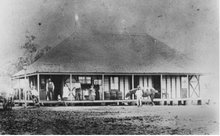Driving home from dropping my children off at school, I had to detour gently around a tortoise making its way slowly across our road. Having no idea what the approach of this roaring monster meant, it rapidly drew itself into its shell and sat in the middle of the road ignoring entirely my need to progress down the road.
It spurred me to think more about the non-human inhabitants of this area. I had been thinking about describing some of the wildlife in the Rosewood Scrub, but I realised that when the Jaeckels arrived here, it was actually scrub, that is, densely treed, while the ecology is now that of open grasslands with occasional remnant patch of scrub. I suspect what they might have seen and heard or even been frightened of, would have been quite different to today.
It’s one of the pitfalls of writing place-specific histories. You think that you know the area and its history, but you have to be aware of changes in environment and ecology. The early settlers were the tools of change, the engine was government policy. Land grants were predicated on successful land clearing – they had five years to build a house and cultivate one-tenth of the land.
Today we have grassland and pasture populated by field birds (crested pigeons, babblers, honeyeaters, masked lapwings, ibis, crows, wagtails, kookaburras, falcons, owls), small rodents such as mice and field rats, reptiles such as bearded dragons, snakes (brown, black, green tree and other), the rarer kangaroo, echidna and tortoise and still the occasional dingo sighting (though this may be local myth as much as anything else).
Inhabitants of the actual scrub would have tended more to native forest birds, some of which can still be seen here like the shrike-thrush, pheasant coucal, cuckoos and others. Snakes would have been plentiful as would more of the smaller forest mammals (wallabies and others) as well as dingoes. I will have to research the ecology of the scrub a little more closely and not depend solely on personal experience and description.
Subscribe to:
Post Comments (Atom)

No comments:
Post a Comment